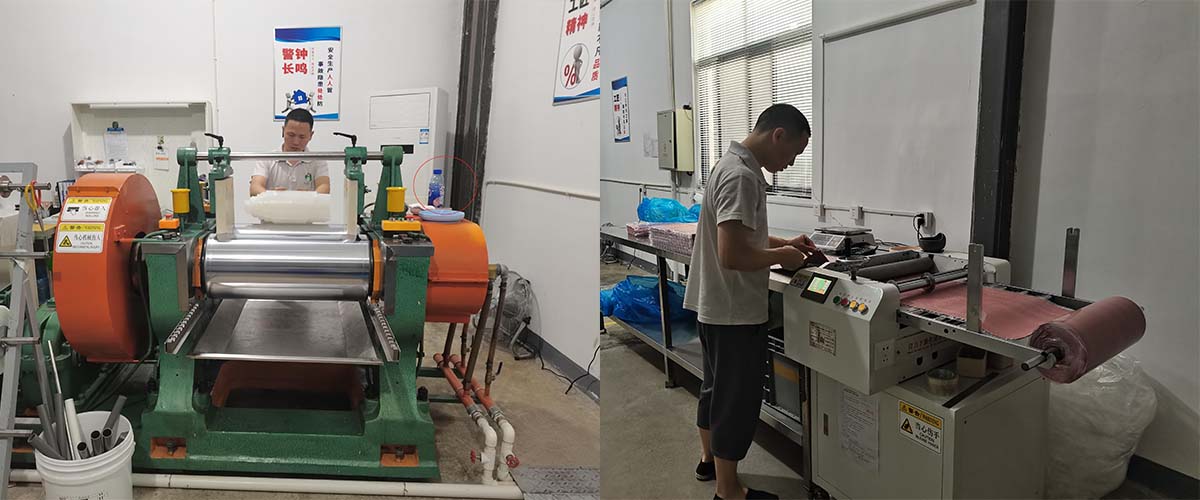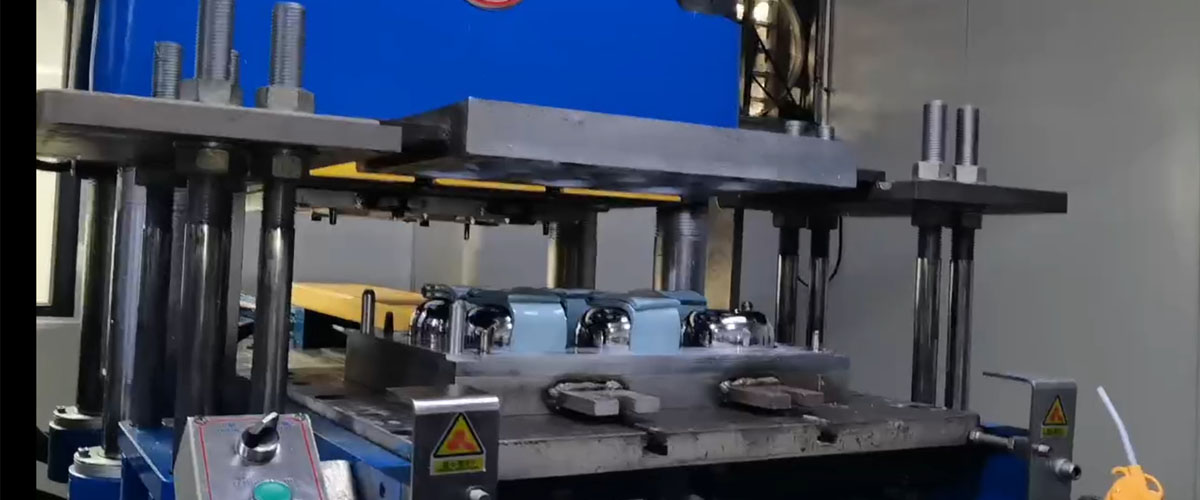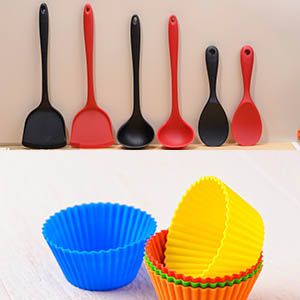
Multifunctional silicone materials with the properties or grades required for the product are obtained through polymerization, hydrolysis, and different manufacturing methods. Common commercial silicone materials are rubber, silicone oil, resin, caulk, and grease. Silicone rubber is a member of the family. Resistance and stability to extreme temperatures make this man-made material suitable for a variety of applications.
In this article, we will focus on exploring the manufacturing process of different types of silicone, including from raw materials, and base compounds to final products.
Now begins our journey of discovery. First, you need to understand the definition of silicone rubber, the different types of silicone rubber commonly used, and the manufacturing process of silicone materials.
What is silicone rubber?
Silicone rubber is an artificial elastomer with a rubber-like consistency made from silicone resin containing oxygen, silicon, carbon, and hydrogen. Its two key properties are excellent temperature and chemical resistance. To meet the needs of harsh environmental applications, silicone polymers can have other additives added to provide specific properties. It is reinforced with silicone and mineral fillers and provides improved performance for a variety of applications. These specific properties can be excellent thermal stability, corrosion resistance, tensile strength, tear strength, flame retardancy, electrical insulation, adhesion, conductivity, and all required colors.
The inert silicone polymer can withstand extreme temperature swings from as low as -110C° (-166°F) to as high as 300C° (572°F). It inherits some of the beneficial properties of silicones over a wide temperature range. Its ease of forming, manufacturing, and unusual properties allow it to be used in diverse applications including maternal and infant feeding, consumer products, construction, mold making, kitchenware, cookware, toys, electronics, coatings, automotive, and aerospace. It is important to note that highly adhesive gels or liquids are usually supplied uncured. These raw materials need to be converted into solids through vulcanization, curing, or catalysis. They usually go through two stages of mixing and molding before reaching their final shape. This is followed by a lengthy post-curing stage. Silicone rubber can be cured using different systems. Common ones are platinum-catalyzed (addition) cure systems, peroxygen cure systems, condensation cure systems, and oxime cure systems. Additionally, providing additional heat or pressure to a platinum-catalyzed cure system can accelerate the solidification process.
Silicone or Silicon? What's the Difference?
The main differences between silicone and silicon are the following:
Production method
Although silicone and silicon are spelled closely, they are completely different materials made from different manufacturing processes.
Chemical structure
Silicone is an elastic material composed of long-chain siloxanes and hydrocarbons. Silicon is a chemical element that does not exist in an isolated form.
Physical characteristics
Silicone is a more pliable, softer man-made material known for its excellent heat resistance. Silicon is a harder, more brittle crystalline solid that has a bluish-gray metallic appearance.
Uses
Silicone is a versatile elastomer. It is heat-resistant, resistant to many chemicals, waterproof, and less reactive than other materials, making it widely used in medical devices, sealants, voltage line insulators, and kitchen tools. Because silicon conducts electricity under certain conditions, it has semiconductor properties. This property makes it an important raw material for the production of semiconductors and solar cells. Especially in electronic product applications, its electrical properties can be precisely controlled by doping impurities.
How are silicone materials produced?
The silicone manufacturing process involves a series of chemical reactions and manufacturing methods. The manufacturing process provides lower-cost, scalable, durable materials for industrial and commercial applications. Now let’s start exploring the key steps involved in the silicone manufacturing process:
Step One: Rich Sources of Raw Materials
Since quartz sand and metallurgical grade gravel contain a high proportion of silica, they become the main raw materials for the manufacturing of silicone. Silica content can be as high as 99.5%.
Step 2: A large amount of quartz sand or metallurgical gravel is mixed with coke, and silicon is separated from silica.
Silicon is produced by reducing quartz with carbon in an electric arc furnace. The maximum reaction temperature of the process is about 1800C°. The reaction products are silicon and carbon monoxide. In the reaction, carbon acts as a reducing agent, removing oxygen from the silica. The purity of silicon obtained through this method is approximately 98%. Pure silicon is also called metallurgical grade silicon. After the reaction is completed, the cooled silicon can be crushed to obtain silicon fine powder.
Step 3: Mixed methyl chloride with metallurgical grade silicon powder, and then heated
Methyl chloride and silicon powder are mixed evenly according to a precise ratio to form dimethyldichlorosilane, the main component of silicone. This process requires heating to activate the reaction between the components.
Step 4: Dimethyldichlorosilane is distilled from the mixture
Mixtures of chlorosilanes with different boiling points are heated to precise temperatures to separate dimethyldichloromethane (DMDCS) and other compounds. The process is long and complicated. You can have dimethyldichloromethane ready for the next stage.
Step 5: Added water and condense
At this stage, dimethyldichlorosilane will undergo hydrolysis after mixing with water and separate hydrochloric acid and disilanol can be obtained. Next, hydrochloric acid acts as a catalyst and condensates with disilanol to produce the most common polydimethylsilanol. Its other chemical name is PDMS.
Step 6: Polymerization to obtain silicone
At this point, you will find that the polydimethylsiloxane contains siloxane bonds. This higher bond energy bond is the backbone of the silicone. Polymerizing silicones involves several different methods. For example, vinyl groups, phenyl groups, or fluorine groups are added to the PDMS chain during synthesis to obtain the finished product’s desired properties and different types of silicones.
What are the different types of silicone?
Different types of silicone rubber have unique properties and benefits, making them the most popular material for a variety of applications. Generally speaking, silicone rubber can be classified based on its molecular structure and the chemical groups attached to the silicon atoms.
Classification based on organic groups on silicon atoms
The organic side groups of silicone rubber usually include methyl group(CH3), vinyl group(CH2=CH), trifluoropropyl group(CF3CH2CH), and phenyl group(C6H5). The classification is as follows:
Methyl (CH3) groups - It is sometimes called methyl silicone rubber or methyl silicone rubber/dimethyl silicone elastomer and is the basic silicone rubber first developed. Its abbreviation is MQ.
Methyl and phenyl groups - its chemical name is PMQ. It is also sometimes known as phenyl silicone rubber/rubber/methylphenyl silicone elastomer. This silicone material performs well at very low temperatures.
Methyl and Vinyl groups- It is also sometimes referred to as methyl vinyl silicone elastomer/rubber. Its chemical name is VMQ. The presence of methyl and vinyl groups gives the polymer its flexibility and adhesive properties. Vinyl-containing silicone compounds also aid in vulcanization.
Methyl, Vinyl, and Phenyl groups - It is generally known for improving the low-temperature properties of rubber.
Fluoro, vinyl, and methyl groups - It is sometimes called fluoroelastomer, fluorinated rubber, or fluorosilicone rubber. These elastomers offer excellent resistance to chemical attack by oils, fuels, and solvents.
Classification based on molecular structure
Types of silicone rubber
|
Viscosity
|
Common processing methods |
Curing system |
Main features and applications
|
LSR (liquid silicone rubber)
|
Lowest |
Liquid silicone rubber (LSR) injection molding |
Platinum additive only | It is a two-component system with the shortest molecular chains. Its unique properties include greater transparency and weather resistance, flexibility, biocompatibility, and chemical inertness. These unparalleled properties make it ideal for applications that require complex geometries, withstand extreme environments, and exposure to harsh chemicals. Particularly suitable for medical device and food contact applications. |
HTV (high temperature vulcanization or solid silicone rubber)
|
Highest
|
Silicone molding or extruding |
Platinum catalyst or organic peroxide | It is a highly versatile and high-performance elastomer, typically with relatively long long-chain polymers. Typically it is supplied in a raw state and requires vulcanization. It is known for its excellent thermal stability, softness, aging and weather resistance, electrical insulation, and hardness. These key properties make it ideal for a variety of demanding applications in various industries. It is particularly suitable for aerospace, automotive, and electrical applications.
|
RTV (room temperature vulcanization)
|
Low to medium |
Molded or cast |
Platinum catalyst | RTV silicone rubber can be a one-component (RTV-1) or two-component (RTV-2) system. Unlike other types of silicone rubber that require high-temperature curing, it cures at room temperature or with only a little heat. It provides hardness from very soft to medium when cured. Its excellent durability, flexibility, mold release, and waterproof properties provide effective surface protection for parts or molds under extreme conditions that may cause other materials to lose elasticity or degrade. Its applications include sealants, adhesives, coating, potting, and packaging.
|
How are silicone raw materials made into final silicone products?
The basic steps of the silicone products manufacturing process include the following:
Mixed
Mixing the raw materials of silicone and other additives into a homogeneous raw material compound. These additives can be reinforcing fillers, cross-linkers, and colors that meet the specific properties required in the final product.
Stired
The mixed compounds are mechanically kneaded under high heat and pressure. The main purpose of this process is to fully disperse all ingredients and produce an uncured material. These base compounds are the raw materials before molding different shapes.
Molding
The base compound is injected into the mold or shaped by other shaping processes. After initial shaping, these shapes will become potentially final usable products after vulcanization.
Vulcanization
The material to be molded is cured or hardened using a curing agent that generates heat. This chemical process is generally completed at room temperature or high temperature. Curing time depends on the size and complexity of the product. Generally, the curing time of the product ranges from a few minutes to 24 hours.
Post-processing options
After the vulcanization process, post-processing including surface treatment or heat treatment may be required on the vulcanized parts. In other words, silicone rubber may undergo certain beneficial processes before use to make it look better and more durable. These post-processings are usually waxing or coating and are done before finishing and cutting.
Silicone products development
The silicone product manufacturing process generally involves several stages from designing parts, building prototypes, precision mold manufacturing, and full-scale production.
Phase One: 2D/3D Drawing
In the initial stage, designers will use CAD or other software-assisted design software to accurately design the product. Once the 3D drawing is complete, it allows engineers to make any modifications before manufacturing the production mold. This step is critical to the success of new silicone product development and also helps visualize the final product and enables designers and engineers to address any design flaws early in the development process and before volume production. Otherwise, once there are errors in the design, they may be propagated to subsequent stages.
Phase 2: Create a prototype, and then test it
The main task of this phase is to create a prototype to prove the concept. Commonly used methods are CNC machining, polyurethane molds, and 3D printing. This depends on the functionality and structural complexity required for the prototype. This important step fully validates design assumptions and evaluates capabilities before mass production. This process may involve iterative revisions to the design.
The third stage: Manufacturing production tool
After final adjustments and approvals are obtained, preparation of the tool or mold for production begins. The quality and precision of the mold determine the final product's size, shape, and quality with the highest consistency.
The fourth stage: Mass production
Finally, these rigorously tested molds are put into mass production using different processing methods. Each molding process has its advantages and is suitable for different types of silicone rubber.
Commonly used silicone processing methods and their advantages
Silicone processing methods involve many types of manufacturing processes. Depending on the many types of silicone, choosing and properly using a manufacturing process for your project transforms the uncured base compound into a final product with unique properties and versatility. The most widely used of these processes are compression molding, liquid silicone rubber injection Forming, extrusion, transfer molding, and calendaring. Let’s take a closer look at these processing technologies and the advantages of each.
Silicone compression molding
Silicone compression molding is a versatile and ancient technology. The manufacturing technology is very simple: Preformed silicone is manually placed on the surface of the heated cavity, and a hydraulic press is used to seal it and begin applying heat and pressure, forcing the molten material to fill the entire cavity. Leave in closed mode until the silicone is completely cured. Products leaving the mold generally involve some flash processing.
Some of its advantages:
Lower production material waste
Short production cycle
Low start-up capital and lower tooling costs
Yield from low to medium
More suitable for large parts where extrusion technology cannot be used
Particularly suitable for parts with curved appearance design requirements in automotive applications

Silicone transfer molding
Silicone rubber transfer molding involves pressing the material into a mold cavity. Like compression molding, the material used is HCR. Move the preset shape into the " pot " area. Under the pressure exerted by the plunger, the material is forced from the gate and runner system into the closed cavity and is heated to a molten state. The material will continue to solidify in the cavity before the mold is opened. Reinforcement of components can also be achieved by placing fibers or matrices before heating.
The advantages of silicone rubber transfer molding are as follows:
Offered tighter tolerances compared to compression moldingd.
Provided efficient and flexible designs as well as high-quality complex geometries.
Completely enclosed and undisturbed by external factors.
Silicone calendering
Silicone rubber calendering is another common processing method for silicone molding. It is a mechanical process. The uncured soft or extruded material is compressed continuously through pairs of heated cylindrical rollers to a sheet of uniform thickness. Continuous, fixed thickness and long silicone sheets can be applied to a variety of substrates. Its consistent thickness, quality, and surface depend on the preset pressure.
Advantages of this processing technology:
Fast, high-volume, continuous production of high-quality products
Acceptable in combination with organic or man-made fabrics.
Application industries are very wide
Liquid silicone rubber injection molding
Liquid silicone rubber injection molding is a manufacturing process that allows for a high degree of automation. It is a two-component system. It is used in its original liquid form. This unheated liquid material is pushed under pressure and fills a completely enclosed heated cavity. It takes on the shape of a cavity after curing. Ejected products do not require additional processing. It should be noted that the material undergoes intense mechanical mixing and is maintained at low temperatures before being pumped into the chamber.
Advantages of this manufacturing process:
Lower labor costs
The shortest production cycle and highly consistent size and accuracy.
Ideal for high-volume, economical and efficient processing
Ideal for parts with complex designs, the tightest tolerances and high precision requirements
You'll find that each molding process has unique characteristics and underlying principles. There are many variables in making the right choice. This depends on the final design complexity of your product, number of production units, cost budget, time to market, and tolerance requirements.
Post-curing of silicone products
The post-cure process for silicone products involves heating the final molded part to a higher temperature for an extended period after the initial cure. For example: Place the produced product in the oven to bake for 2-3 hours. The general temperature setting is 180C°-200C°.
The main purpose of this process is:
Removed the remaining unreacted cross-linker. This improves its mechanical properties including tensile strength and elongation.
Helps in the timely release of volatile substances remaining in silicone. They may be catalysts or other harmful by-products.
The enhancement of the performance of silicone products is crucial for applications requiring high temperatures or harsh conditions. The more stable silicone cross-linked structure provides better resistance to deformation and degradation.
Of course, using different types of silicone rubber may require different post-cure conditions.
Quality control and testing of silicone
Necessary testing and quality control of silicones are key to ensuring a smooth manufacturing process. They include raw material inspection and testing, physical property testing of the manufacturing process, and compliance with certain industry regulations.
Raw material testing
Before entering the warehouse, the type and characteristics of the silicone rubber are strictly tested. Raw material suppliers can be asked to provide relevant reports when necessary.
Confirm specifications
After receiving the production order, the technician produces the test block. Inspectors compare the color and hardness of raw materials. This process ensures that the raw materials are within the tolerances of the specifications.
Manufacturing process quality control
IPQC will conduct regular inspections of products on the assembly line. Once an abnormality is discovered, they promptly notify relevant personnel to deal with it on-site.
Quality inspection method for silicone products
Silicone product performance testing standards include the following:
What are the export standards for silicone products?
LFGB
FDA
ROHS
PAHs
REACH
Halogen test
Conclusion
Understanding the manufacturing processes of different types of silicone rubber can help make the right choice for your project application.
The Yuanyi team with more than ten years of experience provides you with precise production capacity for high-quality silicone products, more efficient management of the manufacturing process, accurate delivery, and multiple options for responsive and high-quality after-sales service. Contact our professional team now, they may become your next reliable partner.


